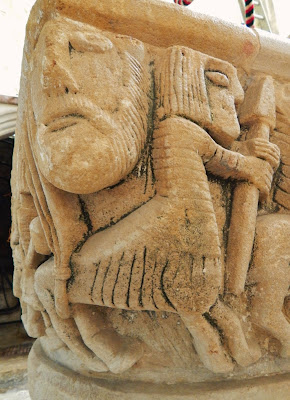An early Norman, or possibly Saxon font in the church of St Mary's, Luppitt, a village to the north of Honiton. The church is on the top of a steep hillside which faces the flat-planed escarpment of Hawkridge and the beech copse-crowned hillfort of Dumpdon. The landscape has considerable power, producing a feeling of deep-layered time. The human millenia of habitation and passage forming a thin, provisional deposit on the surface are condensed and palpably present in the still, raptor-gyred air. The figures on the font, highly modern in their expressive simplicity and stylisation of form, are suffused with this condensed time and communicate directly to us over the centuries. The blankly bulging eyes stare at us with an occluded vision fixed on a focal point far beyond ordinary sight, mesmerically drawing and magnetically holding our rapt gaze. The font was buried in a bank in the graveyard for many centuries before being unearthed by the vicar, one Reverend WT Perrott, in 1890. The golem head, featureless save for a clay-slash of a mouth, was presumably nearest the surface and subject to greater weathering.


Headhunters - martyrdom, sacrifice or battle trophy
Ancient and modern - fixing the gaze
Freefloating spectral head
Almond eyes and Viking beard
Ponderous head with jazz beard
Hunted hare - caught!
Pricked-up hare ears and branchlike stag horns
Hunted hare and stag tangle
Golem!
Chthonic wormbeast - emerging from the deep, dark subsoil
Cthulhu head
Devon Aztec
Stone Muppet - Crazy Harry
Hatchet chopper overbite
Harryhausen face-off - Centaur vs Amphisbaena
Amphisbaena - the two-headed serpentine monster
Traces of the old witchlock - removed by order during Edward VI's reformatory reign
Witch bolt remnants - to guard the blessed water from misuse in charms or unholy rituals
Blue veils and bellropes
































No comments:
Post a Comment